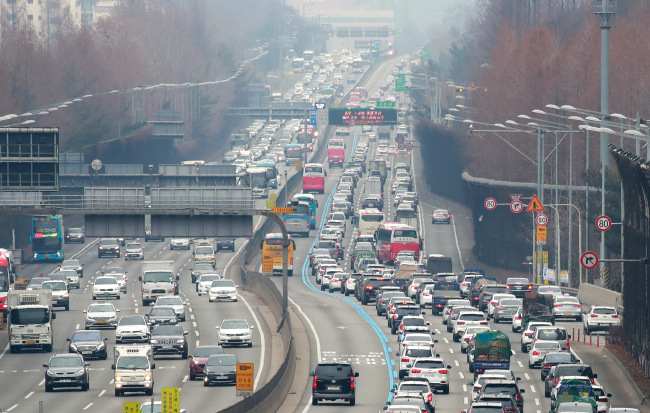Starting from Friday, South Korea braced itself for one of the biggest annual movements of people nationwide as many head to their hometowns for Lunar New Year celebrations next week.
According to the Ministry of Land, Infrastructure and Transport, some 49 million people are expected to hit the road during the holiday that lasts until Wednesday. Traveling from Busan to Seoul by car, for example, would take more than eight hours when people head home on Tuesday afternoon.
 |
Traffic is congested in Jamwon, south of Seoul, on the Seoul-Busan Highway on Friday, the eve of the Lunar New Year holiday. Lunar New Year's Day, which falls on Feb. 5 this year, is a time for family reunions, with Koreans traditionally offering a ritual feast to their ancestors. (Yonhap) |
Seeking to alleviate stress from being stuck in traffic, the tech-savvy nation’s leading telecommunications and IT companies offer predictions of travel time on their navigation systems.
“Real-time navigation service is possible through data sent by average users and taxi drivers every minute, all day long,” said Chung Yeon-joo, who manages the navigation system of Kakao Mobility, a subsidiary of the country’s top messenger app operator Kakao.
According to the company, accurate predictions are possible via massive traffic data collected by its navigation app for the past seven years. Launched in 2011, Kakao navi has emerged as one of the most popular apps among drivers, with up to 1.4 million users.
Last year, the company introduced what it called a “future navigation system.”
By combining big data with sophisticated algorithms, the service allows users to predict how long a journey would take at a certain period of time, Kakao said.
Korea’s largest telecom company, SK Telecom, provides similar predictions for those subscribed to its navigation service, Tmap. Based on data collected over five years, Tmap provides analyses of traffic predictions to its 11 million users, the company said.
“As we expect a dramatic increase in the use of Tmap during the Lunar New Year holiday, we are going to secure an additional server; monitor traffic flow in real time; and carry out prior tests,” SK Telecom said in a press release.
Although the accuracy of such predictions remains to be seen, the tech firms have come up with their own assessments on the ideal time for people to hit the road.
For example, SK Telecom predicted that roads would be most crowded at noon Tuesday. Kakao said the number of travelers would be the highest Friday between 3 p.m. and 7 p.m. and Tuesday between 5 a.m. and 3 p.m.
If drivers in Seoul begin their journey at noon on Tuesday, it would take up to nine hours to arrive at Busan, SK Telecom said. It would take up to more than six hours to travel between Seoul and Gwangju.
According to Kakao, the most ideal timeframe for traveling is between 7:30 p.m. to 9 p.m. Monday. If drivers leave Seoul at 7:30 p.m., it would take less than five hours to reach Busan. A trip between Seoul and Gwangju would take only about four hours, the company said.
By Yeo Jun-suk (
jasonyeo@heraldcorp.com)








